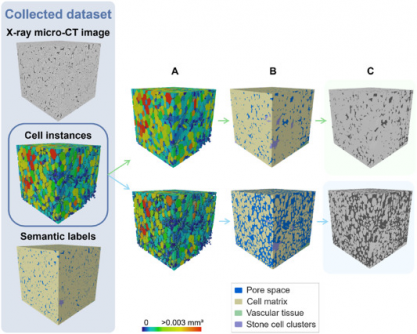Science
Deep Learning Transforms 3D Imaging of Fruit Tissue Structures

A recent study led by Pieter Verboven from KU Leuven has unveiled a groundbreaking deep learning model that significantly enhances the 3D imaging of fruit tissue microstructures. Published on July 5, 2025, in the journal Plant Phenomics, this research offers a fully automated framework for accurately labeling and quantifying plant tissue architecture, surpassing previous two-dimensional methods.
Traditional microscopy techniques have long struggled with the intricate 3D structure of plant tissues, which are crucial for understanding vital metabolic processes. Conventional methods require extensive sample preparation and provide limited fields of view. Although X-ray micro-CT has facilitated non-destructive 3D imaging, it poses challenges in quantifying tissue morphology, particularly due to overlapping features and low image contrast. Existing segmentation techniques often fall short in accurately distinguishing between parenchyma cells, vascular tissues, and stone cell clusters.
To address these challenges, Verboven’s team developed a deep learning-based approach aimed at achieving precise, automated 3D segmentation from native X-ray micro-CT images. The study introduced a 3D panoptic segmentation framework that integrates the 3D extension of Cellpose and a 3D Residual U-Net model. This innovative approach enables simultaneous instance and semantic segmentation, allowing for detailed separation of individual cells and classification of various tissue components.
The model demonstrated exceptional performance when tested on datasets of apples and pears, achieving an Aggregated Jaccard Index (AJI) of 0.889 for apples and 0.773 for pears. In comparison, the two-dimensional model yielded AJIs of 0.861 for apples and 0.732 for pears, while a benchmark model achieved 0.715 and 0.631, respectively.
The deep learning model excelled in segmenting pore spaces and cell matrices, with a Dice Similarity Coefficient (DSC) of 0.506 for vascular tissues in apples and 0.789 in pears. The model also accurately identified stone cell clusters, achieving a DSC of 0.810, with precision and recall rates of 0.798 and 0.836.
Visual validation of segmentations confirmed the model’s accuracy, particularly in detecting vascular bundles in apple varieties such as ‘Kizuri’ and ‘Braeburn’, as well as achieving realistic segmentations of stone cell clusters in ‘Celina’ and ‘Fred’ pears. Despite exhaustive efforts, additional data augmentation did not improve performance, likely due to imbalances within the dataset.
Morphometric analysis further corroborated the model’s accuracy, revealing vascular widths ranging from 70 μm to 780 μm. The study also noted variability in stone cell cluster dimensions and sphericity, which ranged from 0.68 to 0.74.
Overall, this 3D deep learning model represents a significant advancement in the automated and contrast-free quantification of plant tissue microstructure. It provides plant scientists with a powerful tool for investigating how microscopic structures influence water, gas, and nutrient transport. The implications for fruit research are substantial, as it can help elucidate how cellular arrangements affect texture, storability, and susceptibility to physiological disorders like browning or watercore.
Beyond fruit studies, this technology offers a scalable framework applicable to various crops, facilitating research into tissue development, ripening, and stress responses. Its compatibility with standard X-ray micro-CT instruments further enhances its accessibility, enabling greater integration of artificial intelligence into plant anatomy and food science research.
This research received funding from the Research Foundation – Flanders (FWO, grant number S003421N, SBO project FoodPhase) and KU Leuven (project C1 C14/22/076). The findings underscore the potential of deep learning to revolutionize our understanding of plant biology, paving the way for future innovations in the field.
-

 Science2 weeks ago
Science2 weeks agoIROS 2025 to Showcase Cutting-Edge Robotics Innovations in China
-

 Politics2 weeks ago
Politics2 weeks agoJudge Considers Dismissal of Chelsea Housing Case Citing AI Flaws
-

 World2 weeks ago
World2 weeks agoBravo Company Veterans Honored with Bronze Medals After 56 Years
-

 Lifestyle2 weeks ago
Lifestyle2 weeks agoStone Island’s Logo Worn by Extremists Sparks Brand Dilemma
-

 Health2 weeks ago
Health2 weeks agoStartup Liberate Bio Secures $31 Million for Next-Gen Therapies
-

 Top Stories2 weeks ago
Top Stories2 weeks agoIndonesia Suspends 27,000 Bank Accounts in Online Gambling Crackdown
-

 Sports2 weeks ago
Sports2 weeks agoMel Kiper Jr. Reveals Top 25 Prospects for 2026 NFL Draft
-

 Health2 weeks ago
Health2 weeks agoTop Hyaluronic Acid Serums for Radiant Skin in 2025
-

 World2 weeks ago
World2 weeks agoHoneywell Predicts Record Demand for Business Jets Over Next Decade
-

 Sports2 weeks ago
Sports2 weeks agoYamamoto’s Mastery Leads Dodgers to 5-1 Victory in NLCS Game 2
-

 Politics2 weeks ago
Politics2 weeks agoNew Jersey Voters Urged to Register Ahead of November Election
-

 Lifestyle2 weeks ago
Lifestyle2 weeks agoMary Morgan Jackson Crowned Little Miss National Peanut Festival 2025









